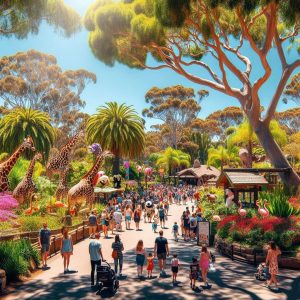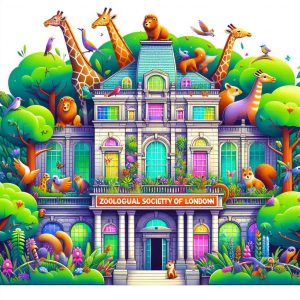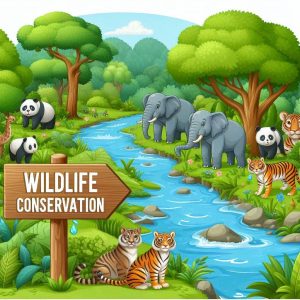Role of Zoos in Wildlife Conservation
Zoos play a crucial role in wildlife conservation by serving as centers for research, education, and species preservation. These institutions contribute significantly to global efforts to protect biodiversity and ensure the survival of endangered species.
One of the primary contributions of zoos to conservation is through their breeding programs. These programs focus on maintaining viable populations of endangered species, often with the goal of reintroducing them into their natural habitats. Zoos collaborate closely with organizations like the World Association of Zoos and Aquariums (WAZA) to coordinate breeding efforts globally.
Wildlife ConservationFor example, the Smithsonian’s National Zoo in Washington, D.C., is renowned for its successful breeding programs for species such as the giant panda and the California condor. These efforts help to increase genetic diversity and prevent the extinction of endangered animals.
Zoos also play a crucial role in educational outreach. Through educational programs, exhibits, and guided tours, zoos educate millions of visitors each year about wildlife conservation and environmental sustainability. By fostering a connection between people and animals, zoos inspire the next generation of conservationists.
Furthermore, zoos contribute to research that enhances our understanding of animal behavior, health, and ecology. Research conducted in zoos provides valuable insights into species-specific needs and informs conservation strategies both in captivity and in the wild.
In addition to their conservation and educational roles, zoos collaborate internationally to support field conservation efforts. They participate in initiatives such as habitat restoration, species reintroduction programs, and wildlife monitoring projects. These collaborations are essential for addressing global conservation challenges and ensuring the long-term survival of species.
Breeding Programs
One of the most significant contributions of zoos to conservation is their involvement in breeding programs for endangered species. These programs help to increase the population of species that are at risk of extinction. For example, the Association of Zoos and Aquariums (AZA) coordinates breeding efforts across many member zoos.
These breeding programs are meticulously managed to maintain genetic diversity and prevent inbreeding. Species such as the giant panda and Fennec fox have seen population increases due to these programs. Success stories include the California condor and the black-footed ferret, both of which were brought back from the brink of extinction through collaborative zoo breeding efforts.
Breeding programs also facilitate the exchange of animals between zoos to ensure genetic diversity. For instance, the European Association of Zoos and Aquaria (EAZA) manages a coordinated breeding program called the European Endangered Species Programme (EEP), which involves the careful planning of breeding activities across multiple institutions.
Educational Outreach
Zoos also serve as important educational resources, offering programs that teach visitors about wildlife and conservation efforts. By fostering a connection between people and animals, zoos inspire visitors to become advocates for conservation. Initiatives like the Wildlife Conservation Society’s education programs are prime examples.
Educational outreach in zoos often includes interactive exhibits, guided tours, and special events designed to engage visitors of all ages. These programs are tailored to raise awareness about specific conservation issues and encourage proactive involvement. For example, the Bronx Zoo offers school programs and summer camps that focus on wildlife conservation and ecology.
Zoos also collaborate with schools and universities to provide educational materials and support for science curriculums. This collaboration ensures that conservation education reaches a broader audience and has a lasting impact. The Smithsonian’s National Zoo is known for its comprehensive educational resources, which include virtual field trips and teacher workshops.
| Zoo | Conservation Program | Impact |
|---|---|---|
| San Diego Zoo | Wildlife Biodiversity Program | Breeding and reintroducing endangered species into the wild. |
| Zoological Society of London | EDGE of Existence | Focuses on conserving the world’s most evolutionarily distinct species. |
| Smithsonian’s National Zoo | Global Health Program | Studies wildlife diseases to improve conservation efforts. |
Research Contributions
Research conducted in zoos provides valuable insights into animal behavior, genetics, and health. This information is critical for developing effective conservation strategies. Notable research institutions, such as the Smithsonian’s National Zoo, contribute significantly to our understanding of wildlife.
Zoos often partner with universities and research organizations to study various aspects of animal biology and ecology. These partnerships have led to breakthroughs in areas such as disease prevention, reproductive technologies, and species reintroduction. The Institute of Zoology at the Zoological Society of London, for instance, conducts cutting-edge research that informs global conservation policies.
Additionally, zoos play a pivotal role in wildlife health monitoring. By studying animals in captivity, researchers can detect emerging diseases and develop strategies to mitigate their impact on wild populations. Programs like the Wildlife Health Program at the Wildlife Conservation Society exemplify these efforts.
The findings from zoo-based research are often shared with conservationists working in the field, helping to improve the success of conservation initiatives. For instance, the EEP (European Endangered Species Programme) benefits from research on breeding and reintroduction practices, enhancing the effectiveness of species recovery programs.
Challenges and Future Directions
Despite their contributions, zoos face challenges such as limited funding and the ethical considerations of keeping animals in captivity. The future of zoos will likely involve a greater emphasis on habitat restoration and in-situ conservation efforts. Collaborations between zoos and international conservation organizations, like the International Union for Conservation of Nature (IUCN), are essential for addressing these challenges.
Zoos Play a Vital Role
Zoos play a vital role in wildlife conservation, contributing significantly to the protection and preservation of endangered species worldwide. These institutions serve as crucial centers for breeding programs, research initiatives, and educational outreach.
First and foremost, zoos provide safe havens for endangered species, helping to maintain viable populations through carefully managed breeding programs. These programs focus on ensuring genetic diversity and preventing the extinction of species such as the giant panda and the Fennec fox.
Moreover, zoos play a crucial role in research contributions to wildlife conservation. Institutions like the Smithsonian’s National Zoo conduct studies on animal behavior, genetics, and health. This research informs conservation strategies and contributes to global efforts to protect biodiversity.
In addition to their conservation efforts, zoos are important educational resources that raise awareness about wildlife and environmental conservation. Through interactive exhibits, educational programs, and outreach initiatives, zoos inspire visitors to become stewards of the environment and advocates for wildlife protection.
Furthermore, zoos collaborate with international organizations and participate in conservation programs like the EEP (European Endangered Species Programme) to enhance their impact on species recovery and habitat preservation.
Despite these contributions, zoos face challenges such as funding constraints and ethical debates surrounding animal captivity. Moving forward, the future of zoos will likely involve greater emphasis on habitat restoration and in-situ conservation efforts, alongside continued advancements in research and education.
| Role | Key Activities | Examples |
|---|---|---|
| Conservation Breeding | Breeding endangered species to maintain genetically diverse populations and support reintroduction programs. | San Diego Zoo’s successful breeding programs for the giant panda and California condor. |
| Research | Conducting scientific research on animal behavior, genetics, and reproductive physiology to advance conservation efforts. | Smithsonian’s National Zoo’s research on animal cognition and conservation biology. |
| Education | Educating the public about wildlife conservation through exhibits, programs, and outreach initiatives. | Zoological Society of London’s educational programs promoting conservation awareness. |
| Public Engagement | Engaging visitors in conservation messages and encouraging sustainable behavior to protect natural habitats. | Educational outreach initiatives by the Bronx Zoo to inspire conservation action. |
Some Zoo are here in details:-
San Diego Zoo
The San Diego Zoo is a world-renowned institution dedicated to wildlife conservation, education, and research. Located in Balboa Park, San Diego, California, this zoo spans over 100 acres and is home to over 3,700 animals representing more than 650 species and subspecies.
Founded in 1916, the San Diego Zoo has a rich history of pioneering efforts in captive breeding, species reintroduction, and conservation science. It is accredited by the Association of Zoos and Aquariums (AZA) and the World Association of Zoos and Aquariums (WAZA).
The San Diego Zoo is renowned for its efforts in breeding endangered species. It has successfully bred species such as the giant panda, California condor, and spotted owl.
In addition to its conservation efforts, the San Diego Zoo is a leader in zoological research. Its Institute for Conservation Research conducts studies on genetics, reproductive physiology, and behavior to advance wildlife conservation globally.
Visitors to the San Diego Zoo can explore various exhibits and experiences designed to educate and inspire. The zoo’s commitment to education is evident through programs such as guided tours, animal encounters, and educational outreach initiatives.
Through its ongoing efforts in conservation, research, and education, the San Diego Zoo continues to be a beacon of hope for wildlife preservation and environmental stewardship.

The San Diego Zoo is committed to wildlife conservation, education, and research.
| Facility | Size | Animal Species |
|---|---|---|
| San Diego Zoo | Over 100 acres | Over 650 species and subspecies |
| San Diego Zoo Safari Park | Over 1,800 acres | Over 300 species |
Animals at San Diego Zoo
San Diego Zoo is home to a diverse array of animal species, representing habitats from around the world. Here are some examples of the animals you can find at the San Diego Zoo:
| Animal | Native Habitat | Conservation Status |
|---|---|---|
| Giant Panda | Bamboo forests of China | Endangered |
| California Condor | Western United States and Baja California, Mexico | Critically Endangered |
| Spotted Owl | Old-growth forests of western North America | Threatened |
| Elephant | Sub-Saharan Africa, Southeast Asia | Vulnerable |
| Koala | Eucalyptus forests of Australia | Vulnerable |
These animals represent a small fraction of the species housed at the San Diego Zoo, where conservation efforts aim to protect and preserve endangered and threatened species.
Zoological Society of London (ZSL)
The Zoological Society of London (ZSL) is a renowned scientific and conservation organization dedicated to promoting and achieving the worldwide conservation of animals and their habitats. Founded in 1826, ZSL operates two world-class zoos: ZSL London Zoo and ZSL Whipsnade Zoo.
ZSL plays a pivotal role in wildlife conservation through its research, education, and field conservation projects around the world. The organization focuses on addressing pressing conservation challenges and promoting biodiversity conservation.
ZSL collaborates with governments, local communities, and other conservation organizations to achieve its conservation goals. Through innovative approaches and partnerships, ZSL continues to make significant strides in protecting endangered species and their habitats.

ZSL is dedicated to promoting global wildlife conservation through science, education, and field projects.
Smithsonian’s National Zoo
The Smithsonian’s National Zoo in Washington, D.C., is a prominent institution dedicated to animal care, conservation, education, and research. Managed by the Smithsonian Institution, the zoo plays a pivotal role in wildlife conservation efforts globally.
Established in 1889, the National Zoo is home to over 2,700 animals representing nearly 400 species. It is accredited by the Association of Zoos and Aquariums (AZA) and participates in numerous conservation initiatives and research projects.
One of the key focuses of the National Zoo is its conservation breeding programs. These programs aim to maintain genetically diverse populations of endangered species and support reintroduction efforts into the wild. Notable successes include breeding programs for the giant panda, California condor, and Asian elephant.
In addition to breeding programs, the National Zoo is at the forefront of zoological research. Its scientists conduct research on animal behavior, genetics, reproductive physiology, and conservation biology. Research findings contribute valuable insights to species management and conservation strategies both in captivity and in the wild.
The National Zoo is also committed to education and outreach. Through educational programs, exhibits, and events, the zoo engages visitors of all ages in learning about wildlife conservation and environmental stewardship. It collaborates with schools, universities, and conservation organizations to promote awareness and inspire action for wildlife conservation.
Moreover, the National Zoo actively participates in collaborative conservation partnerships and initiatives worldwide. These partnerships focus on habitat restoration, species reintroduction, and wildlife monitoring to address global conservation challenges and ensure the long-term survival of endangered species.

The Smithsonian’s National Zoo plays a critical role in wildlife conservation, research, and education.
| Program | Key Activities | Impact |
|---|---|---|
| Conservation Programs | Implementing conservation projects worldwide, including habitat restoration, species recovery, and community engagement. | Contributing to the protection of endangered species and ecosystems. |
| Scientific Research | Conducting research on animal behavior, genetics, reproductive physiology, and conservation biology. | Advancing scientific knowledge and conservation practices globally. |
| Education and Outreach | Educational programs, exhibits, and events to raise awareness about wildlife conservation and inspire action. | Engaging and empowering communities to support conservation efforts. |
Animals at Smithsonian’s National Zoo
Smithsonian’s National Zoo in Washington, D.C., houses a diverse collection of animal species from around the world. Here are some examples of the animals you can find at the National Zoo:
| Animal | Native Habitat | Conservation Status |
|---|---|---|
| Giant Panda | Bamboo forests of China | Endangered |
| Asian Elephant | Forests of Southeast Asia | Endangered |
| Lion | Grasslands and savannas of Africa | Vulnerable |
| Sumatran Tiger | Forests of Sumatra, Indonesia | Critically Endangered |
| Gorilla | Forests of central Africa | Critically Endangered |
These animals are part of the Smithsonian’s National Zoo’s conservation and research efforts aimed at protecting endangered species and their habitats.
FAQs About Zoos in Wildlife Conservation

What is the primary purpose of modern zoos?
Modern zoos primarily aim to conserve wildlife by protecting endangered species, supporting breeding programs, conducting scientific research, and educating the public about biodiversity and conservation issues.
How do zoos contribute to wildlife conservation?
Zoos contribute to wildlife conservation by participating in breeding programs for endangered species, conducting research on animal behavior and health, and raising public awareness about conservation efforts. Many zoos also collaborate with conservation organizations to protect natural habitats and reintroduce animals into the wild.
What are some successful conservation programs led by zoos?
Successful conservation programs led by zoos include the breeding and reintroduction of species such as the California condor, the Arabian oryx, and the black-footed ferret. These programs have helped increase population numbers and restore species to their natural habitats.
How do zoos ensure the welfare of their animals?
Zoos ensure the welfare of their animals by providing enriched environments that meet their physical and psychological needs, implementing rigorous veterinary care, and adhering to strict animal welfare standards. Enrichment activities and proper nutrition are also essential components of animal care in zoos.
What is the role of zoos in educating the public?
Zoos play a vital role in educating the public about wildlife conservation and the importance of preserving biodiversity. They offer educational programs, exhibits, and interactive experiences that inspire visitors to support conservation efforts and adopt sustainable practices.
Disclaimer
The information provided in this FAQ section is intended for educational purposes only. While efforts have been made to ensure the accuracy of the content, it should not be used as a substitute for professional advice or scientific research. Readers are encouraged to consult authoritative sources and experts in the field of wildlife conservation for more detailed information.
Caution
When visiting zoos or engaging in wildlife conservation activities, it is important to follow ethical guidelines and safety protocols. Always respect animal habitats and behaviors, and support zoos that prioritize animal welfare and conservation. Zoos should be chosen based on their commitment to ethical practices and contributions to global conservation efforts.


